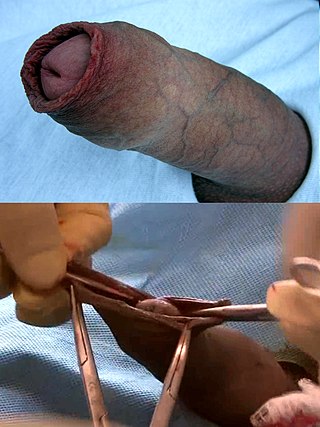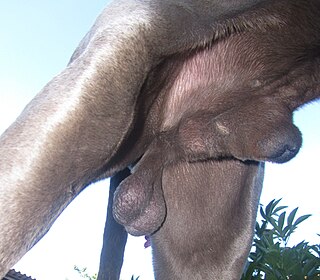
Female genital mutilation (FGM) is the cutting or removal of some or all of the vulva for non-medical reasons. FGM prevalence varies worldwide, but is majorly present in some countries of Africa, Asia and Middle East, and within their diasporas. As of 2024, UNICEF estimates that worldwide 230 million girls and women had been subjected to one or more types of FGM.

Foreskin restoration or foreskin reconstruction refers to the process of recreating the foreskin of the penis, which has been removed by circumcision or injury. Foreskin restoration is primarily accomplished by stretching the residual skin of the penis, but surgical methods also exist. Restoration creates a facsimile of the foreskin, but specialized tissues removed during circumcision cannot be reclaimed. Some forms of restoration involve only partial regeneration in instances of a high-cut wherein the circumcisee feels that the circumciser removed too much skin and that there is not enough skin for erections to be comfortable.
Genital modifications are forms of body modifications applied to the human sexual organs. When there's cutting involved, genital cutting or surgery can be used. The term genital enhancement seem to be generally used for genital modifications that modify the external aspect, the way the patient wants it. The term genital mutilation is used for genital modifications that drastically diminish the recipient's quality of life and result in adverse health outcomes, whether physical or mental.

The Decapolis was a group of ten Hellenistic cities on the eastern frontier of the Roman Empire in the Southern Levant in the first centuries BC and AD. Most of the cities were located to the east of the Jordan Rift Valley, between Judaea, Iturea, Nabataea, and Syria.
Infibulation is the ritual removal of the vulva and its suturing, a practice found mainly in northeastern Africa, particularly in Djibouti, Eritrea, Ethiopia, Kenya, Somalia, and Sudan. The World Health Organization refers to the procedure as Type III female genital mutilation.

In female humans and other mammals, the clitoral hood is a fold of skin that surrounds and protects the glans of the clitoris; it also covers the external clitoral shaft, develops as part of the labia minora and is homologous with the foreskin in the male reproductive system. The clitoral hood is composed of mucocutaneous tissues; these tissues are between the mucous membrane and the skin, and they may have immunological importance because they may be a point of entry of mucosal vaccines.

Paraphimosis is an uncommon medical condition in which the foreskin of a penis becomes trapped behind the glans penis, and cannot be reduced. If this condition persists for several hours or there is any sign of a lack of blood flow, paraphimosis should be treated as a medical emergency, as it can result in gangrene.
Phimosis is a condition in which the foreskin of the penis cannot stretch to allow it to be pulled back past the glans. A balloon-like swelling under the foreskin may occur with urination. In teenagers and adults, it may result in pain during an erection, but is otherwise not painful. Those affected are at greater risk of inflammation of the glans, known as balanitis, and other complications.

The Holy Prepuce, or Holy Foreskin, is one of several relics attributed to Jesus, consisting of the foreskin removed during the circumcision of Jesus. At various points in history, a number of churches in Europe have claimed to possess the Prepuce, sometimes at the same time. Various miraculous powers have been ascribed to it.

Genital piercing is a form of body piercing that involves piercing a part of the genitalia, thus creating a suitable place for wearing different types of jewellery. Nevertheless, the term may also be used pars pro toto to indicate all body piercings in the area of the anus, perineum, penis, scrotum, and vulva, including piercings such as anal, guiche, and pubic that do not involve perforation of genitalia. Genital piercings can be done regardless of sex, with various forms of piercings available. The main motive is beautification and individualization; in addition, some piercings enhance sexual pleasure by increasing stimulation. Pre-modern genital piercings is most culturally widespread in Southeast Asia, where it has been part of traditional practice since ancient times. Records of genital piercing are found in the Kama Sutra.
Male circumcision has been a subject of controversy for a number of reasons including religious, ethical, sexual, and medical.
Circumcision likely has ancient roots among several ethnic groups in sub-equatorial Africa, Egypt, and Arabia, though the specific form and extent of circumcision has varied. Ritual male circumcision is known to have been practiced by South Sea Islanders, Aboriginal peoples of Australia, Sumatrans, and some Ancient Egyptians.

Foreskin piercing is a piercing that passes through the foreskin of the penis. It is the male equivalent of a clitoral hood piercing in females.

A kynodesmē was a cord or string or sometimes a leather strip that was worn primarily by athletes in Ancient Greece and Etruria to prevent the exposure of the glans penis in public and to restrict untethered movement of the penis during sporting competition. It was tied tightly around the akroposthion, the most distal, tubular portion of the foreskin that extends beyond the glans. As depicted in Ancient Greek art the kynodesme was worn by some athletes, actors, poets, symposiasts and komasts. It was worn temporarily while in public and could be taken off and put back on at will. The remaining length of cord could either be attached to a waist band to pull the penis upward and expose the scrotum, or tied around the base of the penis and scrotum so that the penis appeared to curl upwards.

The frenulum of the penis, often known simply as the frenulum or frenum, is a thin elastic strip of tissue on the underside of the glans and the neck of the human penis. In men who are not circumcised, it also connects the foreskin to the glans and the ventral mucosa. In adults, the frenulum is typically supple enough to allow manual movement of the foreskin over the glans and help retract the foreskin during erection. In flaccid state, it tightens to narrow the foreskin opening.

Circumcision is a procedure that removes the foreskin from the human penis. In the most common form of the operation, the foreskin is extended with forceps, then a circumcision device may be placed, after which the foreskin is excised. Topical or locally injected anesthesia is generally used to reduce pain and physiologic stress. Circumcision is generally electively performed, most commonly done as a form of preventive healthcare, as a religious obligation, or as a cultural practice. It is also an option for cases of phimosis, other pathologies that do not resolve with other treatments, and chronic urinary tract infections (UTIs). The procedure is contraindicated in cases of certain genital structure abnormalities or poor general health.

The circumcision of Jesus is an event from the life of Jesus, according to the Gospel of Luke chapter 2, which states:
And when eight days were fulfilled to circumcise the child, his name was called Jesus, the name called by the angel before he was conceived in the womb.

A dorsal slit is a single incision along the upper length of the foreskin from the tip to the corona, exposing the glans without removing any tissue. An ancient practice, it has been a traditional custom among a number of peoples, particularly Filipinos and Pacific Islanders, probably for thousands of years.

In male human anatomy, the foreskin, also known as the prepuce, is the double-layered fold of skin, mucosal and muscular tissue at the distal end of the human penis that covers the glans and the urinary meatus. The foreskin is attached to the glans by an elastic band of tissue, known as the frenulum. The outer skin of the foreskin meets with the inner preputial mucosa at the area of the mucocutaneous junction. The foreskin is mobile, fairly stretchable and sustains the glans in a moist environment. Except for humans, a similar structure known as a penile sheath appears in the male sexual organs of all primates and the vast majority of mammals.

Almost all mammal penises have foreskins or prepuces, although in non-human cases, the foreskin is usually a sheath into which the whole penis is retracted. In koalas, the foreskin contains naturally occurring bacteria that play an important role in fertilization. In some bat species, the prepuce contains an erectile tissue structure called the accessory corpus cavernosum.















